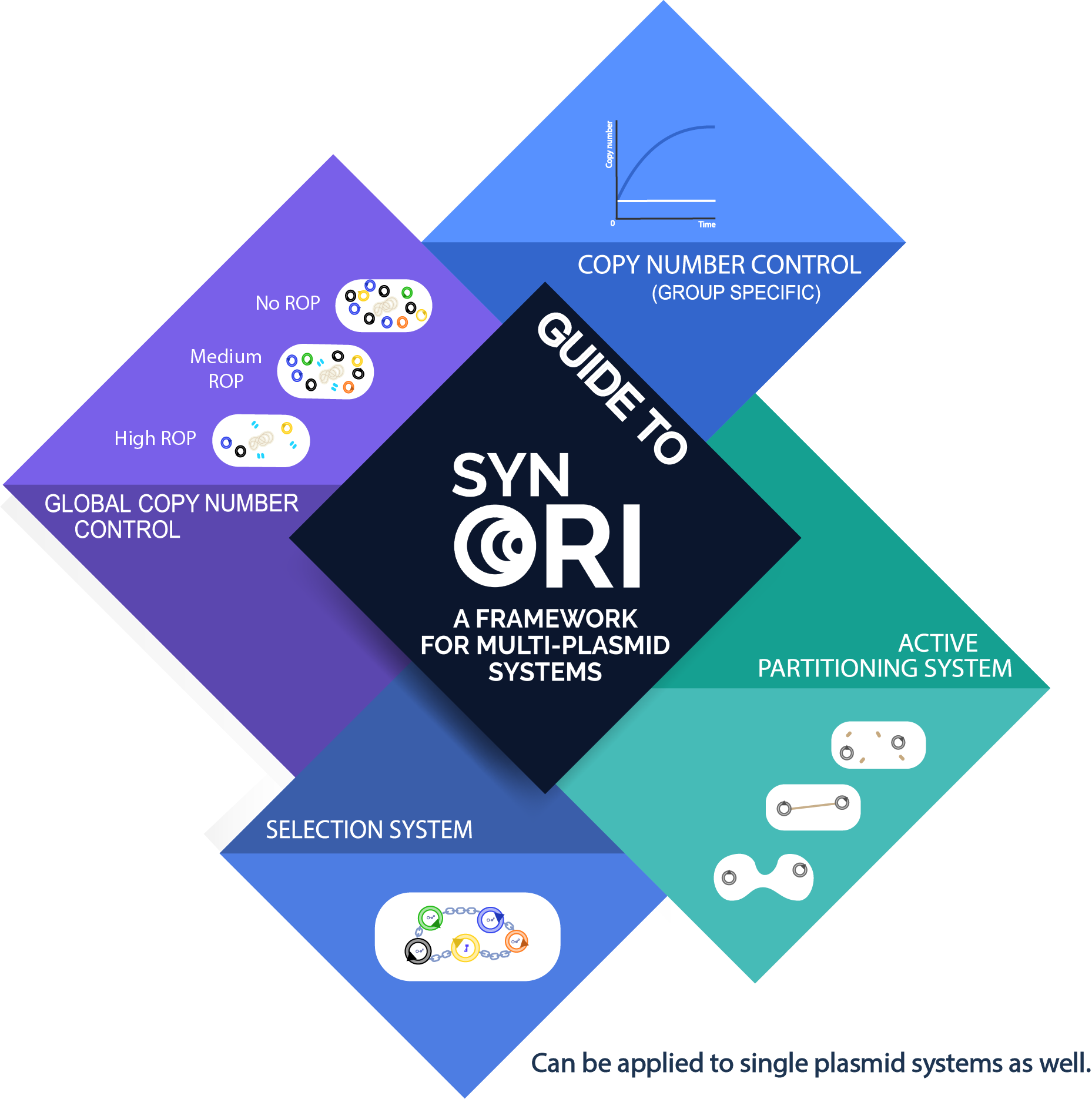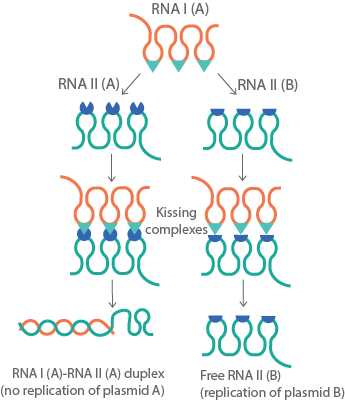Part:BBa_K2259078
SynORI constitutive copy number device (Group B-GC, with RNA II)
This device is a fully functional synthetic origin of replication that sets a constitutive copy number to a plasmid. Different concentrations of RNA I gene provide a different copy number of a plasmid. As it is from group B, its RNA I will only bind to RNA II of the same composite part and not other plasmid groups that might be in a cell.
Three main devices were used for the SynORI proof of concept: Part:BBa_K2259078, Part:BBa_K2259079, Part:BBa_K2259080.
Sequence and Features
- 10COMPATIBLE WITH RFC[10]
- 12INCOMPATIBLE WITH RFC[12]Illegal NheI site found at 684
Illegal NheI site found at 707 - 21COMPATIBLE WITH RFC[21]
- 23COMPATIBLE WITH RFC[23]
- 25COMPATIBLE WITH RFC[25]
- 1000COMPATIBLE WITH RFC[1000]
Contents
Introduction
Biology
ColE1 plasmid replication overview
ColE1-type plasmid replication begins with the synthesis of plasmid encoded RNA II (also called primer transcript) by RNA polymerase which initiates transcription at a site 555bp upstream of origin of replication. The RNA transcript forms a RNA - DNA hybrid with template DNA near the origin of replication. Hybridized RNA is then cleaved at the replication origin by RNAse H and serves as a primer for DNA synthesis by DNA polymerase I (Figure 1. A).[1]
Initiation of replication can be inhibited by plasmid encoded small RNA, called RNA I . Synthesis of RNA I starts 445 bp upstream of the replication origin and proceeds in the direction opposite to that of RNA II synthesis and terminates near the RNA II transcription initiation site. RNA I binds to RNA II and thereby prevents the formation of a secondary structure of RNA II that is necessary for hybridization of RNA II to the template DNA (Figure 1. B).[2]
For RNA I to inhibit primer formation, it must bind before the nascent RNA II transcript extends to the replication origin. Consequently, the concentration of RNA I and the rate of binding of RNA I to RNA II is critical for regulation of primer formation and thus for plasmid replication. [3]
The interaction between RNA I and RNA II can be amplified by Rop protein, see part:BBa_K2259010.
About SynORI
SynORI is a framework for multi-plasmid systems created by Vilnius-Lithuania 2017 which enables quick and easy workflow with multiple plasmids, while also allowing to freely pick and modulate copy number for every unique plasmid group! Read more about [http://2017.igem.org/Team:Vilnius-Lithuania SynORI here]!
Specific RNA I and RNA II versions in SynORI framework
As RNA I and RNA II interact mainly with the three stem loops that form kissing complexes, we have decided to use this fact to our advantage in order to engineer different plasmid groups by adding unique, group-specific sequences to RNA I and RNA II stem loops.
For example if there are two plasmid groups in a cell - A and B - RNA II of A group would only interact with RNA I A, and not RNA I B.
The inactivation and transfer of RNA I gene away from RNA II allow us to use different sequences for RNA I and RNA II molecules that are not necessarily ideal complements of each other.
Since there are three stem loops responsible for RNA I – RNA II interaction for each of the plasmid group we have decided to:
- Use two different unique sequences in the first two stem loops, in order to maximize same group specificity.
- For the third loop, we have decided to keep RNA II unchanged, and add either G/C mutations (GC type RNA I) or make RNA I completely non-complement to RNA II (NC type RNA I).
We did not want to introduce new specific sequences into the third loop of RNA II sequence. That is because according to literature <links> RNA II secondary structures at third loop structure are very sensitive to any mutations and has a high chance of ruining the replication initiation. Just because we chose not to interfere with the third loop of RNA II, we could not leave RNA I gene unchanged. If every group would have the fully compatible third loop, the background cross-group inhibition would be too large.
So now we have 5 different RNA II genes corresponding to groups A B C D and E.
Also, we have 10 different RNA I alternatives: A, B, C, D, E with each having a version of either G/C or NC mutations.
So for example, if we have a part named RNA I (B-NC), it means: This RNA will only selectively regulate RNA II molecule by having specific B group sequences in first two stem loops. Also, in the third stem loop every nucleotide is not complementary to RNA II third loop.
These different plasmid groups (A-E) can then be co-maintained in a cell with a specific, pre-selected copy number. Copy number control principle is the same for every group, but each group is only specific to its own group.
Origin of seperate RNA I and RNA II biobricks
If RNA II and RNA I are naturally an antisense system, why are there two separate constructs in SynORI system? In order to flexibly control the synthesis of RNA I, the RNA I gene first needed to be inactivated in the ColE1 origin of replication. That, however, was not a trivial task, because by changing RNA I promoter sequence, one also changes the RNA II secondary structure, which is crucial for plasmid replication initiation (Find how this problem was solved at [http://2017.igem.org/Team:Vilnius-Lithuania team Vilnius-Lithuania wiki]). This is the main reason why, in the SynORI framework, the wildtype ColE1 ORI is split into two different parts - RNR I and RNA II .
Characterization (Vilnius-Lithuania 2017)
SynORI proof of concept
To be updated!
References
- ↑ Itoh, T. and Tomizawa, J. (1980). Formation of an RNA primer for initiation of replication of ColE1 DNA by ribonuclease H. Proceedings of the National Academy of Sciences, 77(5), pp.2450-2454.
- ↑ Tomizawa, J. (1984). Control of cole 1 plasmid replication: The process of binding of RNA I to the primer transcript. Cell, 38(3), pp.861-870.
- ↑ Tomizawa, J. (1984). Control of cole 1 plasmid replication: The process of binding of RNA I to the primer transcript. Cell, 38(3), pp.861-870.
//collections/synori
| None |




